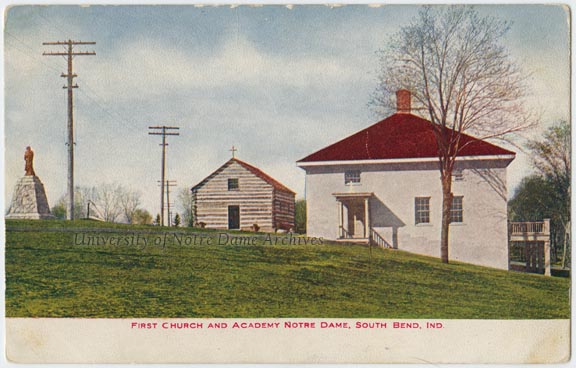
On March 10, 1876, Alexander Graham Bell used a liquid transmitter and electromagnetic receiver to relay his famous telephone message to Thomas Watson. Bell, Thomas Edison, and other inventors raced to perfect the telephone. The new technology arrived at Notre Dame on April 4, 1878: “a telephone was attached to the telegraph wires at Notre Dame connecting to South Bend. Conversation was freely carried on and music played at Notre Dame was distinctly heard at South Bend.” Over the next several days, crowds gathered at both ends of the phone lines, presenting concerts to one another [Scholastic, 04/06/1878, pages 506 and 522].

Phones were eventually placed in various offices on campus and grew in number over time. It wouldn’t be until 1968 when students would have phones in their individual dorm rooms. In the meantime, students had little privacy when placing and receiving calls, as the phones were placed near the rectors’ offices or in other rather public places. Even with the convenience of a booth, little was left to the imagination of the casual passer-by: “The scene, Room 117 in the Main Building. Back of this room is the Brownson telephone booth, hallowed by the ravings of many a love-lorn student…” [Dome yearbook 1918, page 331].
Over the years, Notre Dame worked with various telephone providers to upgrade the systems and to negotiate better rates. In 1937, a telephone exchange was established at Notre Dame. One could now connect to another on-campus phone by dialing directly. However, out-of-city calls still required assistance from a Notre Dame operator. Many Notre Dame engineering alumni who were employed by Indiana Bell Telephone Company worked on this major upgrade to the campus telephone system [Scholastic, 05/14/1937, page 7].
In 1963, the University switched to a Centrex system, which helped to lower the costs of long-distance calls and allowed for all faculty members and most administrative staff members to have their own lines. The switchboard was no longer needed for long-distance incoming or outgoing calls, but was retained for informational services. This system change also laid the groundwork for students to finally have their own phones, although it took five years to get there [Notre Dame, Fall 1963, page 11]. In 1968, “the impenetrable lines to Saint Mary’s finally broke in January when private phones were installed in each room” [Dome yearbook 1968, page 234].

The 1992 upgrade resulted in the prefix of all University phones changing to the now familiar 631 (ND-1) prefix for faculty and staff lines and 634 (ND-4) for student lines. Voicemail access became 634-7474 (ND-IRISH).
In the 1990s, students registered for classes via Direct Access Registration by Telephone (DART). The allotted fifteen minute registration time was made stressful by busy tones, closed classes, and the fear of a disconnection. By the early 2000s, class registration was made more efficient by using the internet.

In 2006, Notre Dame removed land-line phones in each dorm room as few students were actually using them in favor of their cell phones. The Office of Information Technologies (OIT) installed house phones on every floor of the dorms for student use, reminiscent of the lamented system in place in the 1960s. Students can still opt-in to have a land-line in their rooms, at an added charge, although few do.
In 2011, Notre Dame migrated phone service to “the computer data network instead of the traditional phone line” [http://myphone.nd.edu/], which also provided faculty and staff with many new calling features. Other than getting used to a new handset, many of the changes were not apparent to the end user.
Sources:
“Timeline of the Telephone,” wikipedia.org
PNDP 30-Te-2
Scholastic
Dome yearbook
PNDP 83-Nd-3s: “Now – Dial Any Notre Dame Office Direct with Prefix 284 and the Number,” Notre Dame, Fall 1963, page 11
“University cuts dorm telephones,” by Amanda Michaels, Observer, 08/23/2006
“Residence Hall Opt-In Phone Service FAQ,” OIT website
http://myphone.nd.edu/
GFCL 48/62
GDOM 7/45
GSCO 1/58

Thanks for the information, Steve!
In the next to last paragraph, the reference to the 2006 initiative for the elimination of land-line dorm phones also included other technology driven decisions. For example, Cable TV (CaTV) was installed in every dorm room. Also, it provided for the saturation of WiFi service (wireless internet access) in each dorm for student access. Finally, cellular service was improved to compensate for the loss of land-lines by the installation of a Distributed Antenna System (DAS) for improving the service provided by the largest cellular service carriers of that time, Verizon, AT&T, and later, Sprint. This was one of the first large scale cellular DAS deployments on a major university campus at that time.
How amazing this bit of history on ND and phones. Great article. What a long way we’ve come